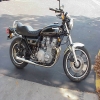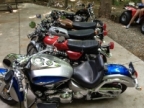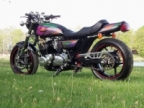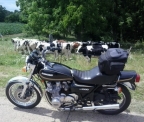- Posts: 175
- Thank you received: 3
bike mothballing
- hydrolazer
-
 Topic Author
Topic Author
- Offline
- User
\'79 kaw 1000 ltd
Please Log in or Create an account to join the conversation.
- 4TheKZ1000
- Visitor
1. Location - where are you going to put it?
One solution may be to ask your dealer if he offers a storage program. This is ideal because he will often prep, store, and have the bike ready to ride when you are ready again. If you decide to store it yourself, you will need a place that is dry and out of harm's way. When possible,. chose a location away from windows. The ultraviolet light can fade paint and plastic parts. Direct sunlight can raise the ambient temperature of the storage area which will promote condensation when the sun goes down, so cover plain glass with some sort of opaque material. Also, cover your bike with a specially designed bike cover not a sheet or a tarp. Why? Because a sheet absorbs moisture and hold it against metal surfaces and then rust forms. Also, damp fabric will breed mildew and this may attack the seat material. A tarp prevents moisture from getting in but it also prevents it from getting out. Moisture trapped will condense on the bike and then the rust monster is back!
A specially designed motorcycle cover is made of a mildew resistant material. The material is slightly porous, so it can breathe.
2. Change The Oil
Tip: Just like cars a cold winter grade oil will allow your bike to start easier in colder weather. If your motorcycle runs ok with a cold winter grade oil (5w30) then changing the oil to this grade will help startup and running in spring.
Even if the oil is not due for a change, byproducts of combustion produce acids in the oil which will harm the inner metal surfaces. Warm the engine to its normal operating temperature, as warm oil drains much faster and more completely.
While you are at it, why not change the filter too? Add fresh motorcycle grade oil. Remember to dispose of the drained oil and old filter in a responsible manner. What to do with the old oil? Recycle it. Most stores you have purchased the oil from will take it back free of charge to be recycled.
3. Add Fuel Stabilizer And Drain Carbs
Tip: You only need to drain the carbs if your motorcycle will be stored more than 4 months. Otherwise just add fuel stabilizer to the gas tank, run the bike for 10 minutes so it mixes and gets into the carbs.
Fill the tank with fresh fuel, but do not overfill. The correct level is when the fuel just touches the bottom of the filler neck. This gives enough room for the fuel to expand without overflowing the tank when temperature rises.
Shut off the fuel petcock and drain the carburetors and the fuel lines. Add winterizing fuel conditioner to prevent the fuel from going stale, and help prevent moisture accumulation. Stale fuel occurs when aromatics (the lighter additives) evaporate leaving a thicker, sour smelling liquid. If left long enough, it will turn into a gum, plugging the jets and passages inside your carbs!
4. Lube the cylinder(s)
Tip: You only need to do this if your motorcycle will be stored a very long time (6 months or more)Because gasoline is an excellent solvent and the oil scraper ring has done its job, most of the oil from the cylinder walls have been removed since the last time the engine was run. If the cylinder wall is left unprotected for a long period of time, it will rust and cause premature piston and ring wear.
Remove the spark plugs and pour a tablespoon (5 cc) of clean engine oil or spray fogging oil into each cylinder. Be sure to switch off the fuel before you crank the engine or else you may refill the drained carbs! Also, ground the ignition leads to prevent sparks igniting any fuel residue. Turn the engine over several revolutions to spread the oil around and then reinstall the plugs. Refitting the plugs before cranking the engine could result in a hydraulic lock if too much oil was used in the cylinder.
5. Battery Storage
The battery must be removed from the motorcycle when it is in storage. Motorcycles often have a small current drain even when the ignition is switched off (dark current), and a discharged battery will sulfate and no longer be able to sustain a charge. A conventional battery should be checked for electrolyte level. Add distilled water to any of the cells that are low and then charge the battery.
Battery charging should be performed at least every two weeks using a charger that has an output of 10% of the battery ampere hour rating. For example if the battery has an AH rating of 12 (e.g. 12N12A-4A-1 where the 12A is 12 amp hours), then the charge rate of that battery should not exceed 1.2 amps. A higher charge will cause the battery to overheat. Charge the battery away from open flame or sparks as the gas (hydrogen) given off a battery can be explosive. Elevate the battery and keep it from freezing. Exercise the proper caution appropriate to caustic substances.
6. Surface Preparation
Waxing and polishing the motorcycle might seem like a waste of time since you are putting it away and no one will see it. But applying wax is a very important part of storing a motorcycle. Wax will act as a barrier against rust and moisture.
Don't forget to spray any other metal surfaces (such as the frame or engine) will a very light spray of WD-40. This will keep these areas shiny and protect from corrosion as well.
7. Exhaust and Mufflers
Exhausts/Mufflers are known to rust fast when they are not used. So making sure they are properly stored for the winter on your bike will save them from an early rusty death. Spray a light oil (such as WD40) into the muffler ends and drain holes. Lightly stick a plastic bag (shopping bag is fine) into the end of each muffler hole (to keep moisture from getting inside the exhaust). Then cover each muffler with another plastic bag to keep outside moisture off.
8. Tires
Check both front and rear tires with your air pressure gauge. Make sure each tire is properly inflated to the maximum recommend pressure. As it gets colder, air condenses in your tire so it is important to pump them up as to keep your tires healthy. Rubber is a flexible material and does not like to freeze (it cracks when it freezes). Placing 1/4"-1/2" piece of cardboard or wood board under each tire will help keep the rubber raised up from a freezing floor.
DO NOT use a tire dressing on tires (such as Armor-All or tire cleaning foam) as this will make the tires hard and slippery.
9. Service all fluids
If the brake or clutch fluids haven't been changed in the last two years or 18,000 km (11,000 miles), do it now. The fluids used In these system are "hygroscopic" which means that they absorb moisture. The contaminated fluid will cause corrosion inside the systems which may give problems when the motorcycle is used next spring. Be sure to use the correct fluids and note the warnings and instructions in the service manual. If you don't have the experience to service these systems, contact your dealer, he will be happy to assist you.
If your motorcycle is liquid cooled, the coolant requires changing every two years or 24,000 kms (15,000 miles). Make sure that the engine is cool enough to rest your hand on it before draining the system and please dispose of the coolant responsibly. Coolant/antifreeze is available from your dealer and has been developed to provide the correct protection for your motorcycle engine. Mixed 50/50 with distilled water will ensure a clean system for the next two years or 24,000 kms (15,000 miles).
10. Cover it.
Now you can cover the bike with the cycle cover and look forward to the first warm day of spring.
Back On The Road
Before you head out onto the highway, there are a couple of things to do. First, remove the cover and put it where you can find it again. Talking of finding things, locate the (charged) battery and reinstall it connecting the positive (+) cable (red) before the (-) negative and covering the terminals with the plastic covers. Recheck all fluid levels and turn on the fuel. Check for anything wrong on the motorcycle (cracked tires, broken parts/plastic, leaking oil). Set the tire pressures back to riding specs and you are ready to fire up.
Please Log in or Create an account to join the conversation.
- 650ed
-

- Offline
- User
- Posts: 15344
- Thank you received: 2829
hydrolazer wrote: in less than 2 weeks i will be having shoulder surgery again. the last time i left the bike full of gas so the tank wouldnt rust. the results were terrible. the tank didnt rust but the carbs(even though completely drained)were clogged with ethanol residue so bad they had to be soaked in cleaner and new kits installed. i dont want to go through this again. im thinking this time to get out all the gas and this time fill it with diesel. diesel has rust protection, dont go bad and no ethanol. i know the bike will smoke a bit when i drain the system and refuel with gas. ha anyone tried this?,,,tia,,hydro
I would not be putting diesel in there. It sounds like your petcock was leaking and allowed fuel to go into the carbs after you had drained them. If it was mine and I couldn't rely on the petcock not to let fuel seep into the carbs, I would replace the petcock. BUT, if time or other constraints prevent you from doing that consider the following. You could get a piece of spare fuel line and insert a plug into one end securing it with a hose clamp. Remove the current fuel line from the petcock and attach the spare piece (with the plug) to the petcock. Fill the fuel tank as full as possible to prevent rust. Turn the petcock off, but even if it allows fuel to pass the plug will keep it from leaking on the bike (just make sure you test the plug first). Drain the carbs. This time they will remain drained since they are no longer attached to the fuel tank. The tank should remain rust-free because it is full of fuel, and the carbs should remain clean because they are drained. Ed
1977 KZ650-C1 Original Owner - Stock (with additional invisible FIAMM horn)
Please Log in or Create an account to join the conversation.
- kzcurt
-

- Offline
- User
- Posts: 170
- Thank you received: 21
If anything maybe Mavels Mystery Oil?
Flag carrier #23
9 @ 50-2053,
Please Log in or Create an account to join the conversation.
- les holt
-

- Offline
- Vendor
- Posts: 1635
- Thank you received: 288
Les
Please Log in or Create an account to join the conversation.
- bluej58
-

- Offline
- Sustaining Member
- The chrome don't get you home
- Posts: 2484
- Thank you received: 511
Then down the road when you are ready to ride again dump the gas in your work truck and get fresh stuff
Well that's what I would do anyway
Good luck with your surgery .
JD
78 KZ1000 A2A
Please Log in or Create an account to join the conversation.
- 650ed
-

- Offline
- User
- Posts: 15344
- Thank you received: 2829
bluej58 wrote: If you fill the tank all the way up and disconnect the fuel lines like Ed says, add some marine Stabil to the gas.
Then down the road when you are ready to ride again dump the gas in your work truck and get fresh stuff
Well that's what I would do anyway
Good luck with your surgery .
JD
+1
1977 KZ650-C1 Original Owner - Stock (with additional invisible FIAMM horn)
Please Log in or Create an account to join the conversation.
- hydrolazer
-
 Topic Author
Topic Author
- Offline
- User
- Posts: 175
- Thank you received: 3
\'79 kaw 1000 ltd
Please Log in or Create an account to join the conversation.
